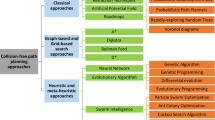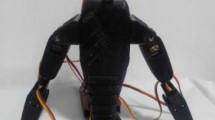Abstract
Constrained motion and redundant degrees of freedom control exist in a multi-manipulator collaboration system. In other words, the multi-manipulator collaboration technology must solve the problems of uncertain environment interaction and coordinated control. Few studies have been conducted on the coordination control of a multi-manipulator, and the control effect is not good. To solve the coordinated motion problem of the multi-manipulator cooperative system, this study divides the multi-manipulator coordinated motion into two forms, namely coupled and superimposed motions, and proposes an adaptive coordinated motion constraint scheme under different motion forms. The coupled and superimposed motions are investigated through coordinated handling and coordinated drawing circle tasks, respectively. The proposed coordinated control scheme has a good effect. Without position detection and positioning, the kinematic constraint algorithm can maintain the relative motion relationship between end-effectors. When an external disturbance occurs, the slave manipulator can automatically adjust based on the position of the main manipulator, avoiding error accumulation. The experimental results show a maximum trajectory tracking error of 2.131 mm and maximum attitude error of 0.176°, indicating that the proposed control scheme has strong adaptive ability and high control accuracy.















Similar content being viewed by others
Availability of data and material
The data of this study cannot be shared publicly.
References
Ning Z (2018) Typical mechanical arm research status were reviewed. Information Recording Materials
Lindner T, Milecki A, Wyrwa D (2021) Positioning of the robotic arm using different reinforcement learning algorithms. Int J Control Autom Syst 19(4):1661–1676
Li D, Qi F, Dai X (2017) Research status of multi-robot systems task allocation and uncertainty treatment. J Phys Conf Ser 887(1):012081
Ni J , Shi H , Wang M (2020) Disturbance observer-based cooperative learning tracking control for multi-manipulators. In 2020 7th International Conference on Information, Cybernetics, and Computational Social Systems (ICCSS)
Liu X, Zhang P, Guanglong D (1973) Hybrid adaptive impedance-leader-follower control for multi-arm coordination manipulators. Industrial Robot: An International Journal
Slota A (2014) bezier curve based programmed trajectory for coordinated motion of two robots in Cartesian space. Appl Mech Mater 555:192–198
Muscio G, Pierri F, Trujillo MA, Cataldi E (2016) Experiments on coordinated motion of aerial robotic manipulators. In 2016 IEEE International Conference on Robotics and Automation (ICRA). IEEE
Zhai F, Wei L, Han S, Li R (2017) Vertical lifting control of forging manipulator clamp based on multi-actuator coordination. Forging & Stamping Technology
Coelho L, Pessa MW (2011) A tuning strategy for multivariable PI and PID controllers using differential evolution combined with chaotic Zaslavskii map. Expert Syst Appl 38(11):13694–13701. https://doi.org/10.1016/j.eswa.2011.04.156
Ayala H, Coelho L (2012) Tuning of PID controller based on a multiobjective genetic algorithm applied to a robotic manipulator. Expert Syst Appl 39(10):8968–8974. https://doi.org/10.1016/j.eswa.2012.02.027
dos Santos Coelho L, Mariani VC (2012) Firefly algorithm approach based on chaotic Tinkerbell map applied to multivariable PID controller tuning. Comput Math Appl 64(8):2371–2382. https://doi.org/10.1016/j.camwa.2012.05.007
Bing Z, Yan X (2007) Robust control of a 3DOF hybrid robot manipulator[J]. Int J Adv Manuf Technol 33(5–6):604–613. https://doi.org/10.1007/s00170-006-0474-x
Xidias E, Moulianitis V, Azariadis P (2021) Optimal robot task scheduling based on adaptive neuro-fuzzy system and genetic algorithms. Int J Adv Manuf Technol 115:927–939. https://doi.org/10.1007/s00170-020-06166-0
Norman AR, Schönberg A, Gorlach IA (2013) Validation of iGPS as an external measurement system for cooperative robot positioning. Int J Adv Manuf Technol 64:427–446. https://doi.org/10.1007/s00170-012-4004-8
Wang L (2015) Collaborative robot monitoring and control for enhanced sustainability. Int J Adv Manuf Technol 81:1433–1445. https://doi.org/10.1007/s00170-013-4864-6
Haitao Z, Licai T (2015) Path planning algorithm for dual arm coordinated operation of space manipulator. Control Eng 22(6):1028–1033
Park HA, Lee C (2016) Dual-arm coordinated-motion task specification and performance evaluation. IEEE/RSJ International Conference on Intelligent Robots & Systems. IEEE, pp 929–936
Davidson JR, Hohimer CJ, Mo C et al (2017) Dual robot coordination for apple harvesting. Asabe International Meeting
Wang X, Chen L (2020) A Vision-based coordinated motion scheme for dual-arm robots. J Intell Robot Syst 97(1):67–79
Wu J, Jin Z, Liu A et al (2020) Vision-based neural predictive tracking control for multi-manipulator systems with parametric uncertainty. ISA Trans. https://doi.org/10.1016/j.isatra.2020.10.057
Shen H, Pan YJ, Bauer G (2020) Online noise-estimation-based neighbor selection for multi-manipulator systems. IFAC-PapersOnLine 53(2):9802–9807. https://doi.org/10.1016/j.ifacol.2020.12.2679
Bergamaschi PR, Saramago SDFP, Coelho L (2008) Comparative study of SQP and metaheuristics for robotic manipulator design. Appl Numer Math 58(9):1396–1412. https://doi.org/10.1016/j.apnum.2007.08.003
Xu R, Luo J, Wang M (2020) Manipulability optimization for coordinated motion control of multi-arm space robots. IFAC-PapersOnLine 53(2):9853–9858. https://doi.org/10.1016/j.ifacol.2020.12.2690
Zhang T, Fan O (2012) Offline motion planning and simulation of two-robot welding coordination. Front Mech Eng 7(001):81–92
Hou Y, Wang T, Yue J, Jia Z (2018) Path planning for dual-robot coordinate welding based on multi-objective genetic algorithm. Zhongguo Jixie Gongcheng/China Mechanical Engineering 29(16):1984–1989
Xiong J, Fu Z, Chen H, Pan JP, Gao XS, Chen XB (2020) Simulation and trajectory generation of dual-robot collaborative welding for intersecting pipes. Int J Adv Manuf Technol 111:2231–2241. https://doi.org/10.1007/s00170-020-06124-w
Xiao JL, Zhao SL, Guo H (2019) Research on the collaborative machining method for dual-robot mirror milling. Int J Adv Manuf Technol 105:4071–4084. https://doi.org/10.1007/s00170-018-2367-1
Wang Z, Gan Y, Dai X (2018) Human-robot distance modeling and minimum distance iterative algorithm in collaboration environment. Jiqiren/Robot 40(4):413–422
Yuguang D, Chen Q (2016) Kinematics analysis of dual robot coordination. Manufacturing automation 038(002):63–66
He BB, Huang QD (2019) Research on dual robot coordinated joint control based on task priority selection method. Machine tool and hydraulic (15)
Tian Y, Wang B, Liu J, Hao S, Long L (2018) Stiffness modeling and analysis of a multiple coordinated robot system[J]. Int J Adv Manuf Technol 94(1):1–12
Funding
This work was supported by the National Natural Science Foundation of China (Grant No. 51305241), the Natural Science Foundation of Shandong province (Grant No. ZR2018MEE022), and the Youth Entrepreneurship Fund of Shandong Higher Education Institutions (Grant No. 2019KJB015).
Author information
Authors and Affiliations
Contributions
In this study, the coordinated motion of a multi-manipulator is divided into two types: coupling and superposition motions. An adaptive coordinated motion constraint scheme is proposed for the two different motion forms. Solve the problem of coordinated motion control of multi-manipulator cooperation system.
Corresponding author
Ethics declarations
Ethics approval
Not applicable.
Consent to participate
Not applicable.
Consent for publication
This article agrees to be published.
Competing interests
The authors declare have no competing interests.
Additional information
Publisher's Note
Springer Nature remains neutral with regard to jurisdictional claims in published maps and institutional affiliations.
Rights and permissions
About this article
Cite this article
Su, C., Zhang, M., Zhang, S. et al. Adaptive coordinated motion constraint control for cooperative multi-manipulator systems. Int J Adv Manuf Technol 119, 4203–4218 (2022). https://doi.org/10.1007/s00170-021-08621-y
Received:
Accepted:
Published:
Issue Date:
DOI: https://doi.org/10.1007/s00170-021-08621-y




